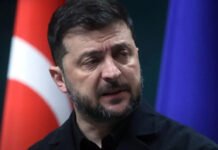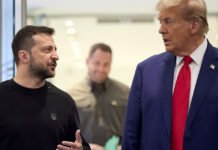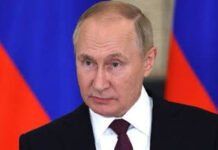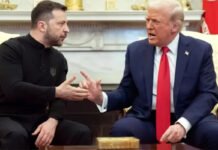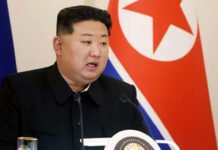The geopolitical landscape is witnessing a significant shift as US President Donald Trump intensifies his stance against Russia amid the ongoing conflict in Ukraine. Having long threatened sanctions targeting Russia’s vital oil industry, recent developments show a marked escalation, with Trump now authorizing weapon supplies to Ukraine and preparing to enforce even tougher sanctions. This article delves deep into these critical moves, the upcoming NATO meetings, and the broader implications on global security and energy markets.
Trump’s Strategic Pivot: From Sanctions Threats to Weapon Supplies
President Trump’s approach toward Russia has evolved noticeably over the past months. While initially hesitant, often dismissing support to Ukraine as an undue burden on American taxpayers, Trump’s administration is now signaling a firm commitment to countering Russian aggression. This change is driven by mounting concerns over Russia’s sustained military actions in Ukraine, compelling Trump to authorize the sale and transfer of weapons to NATO allies. These allies, in turn, are empowered to channel these arms directly to Ukraine, a move designed to bolster Kyiv’s defensive capabilities.
This weapon supply strategy is critical. It not only strengthens Ukraine’s frontlines but also sends a clear message of solidarity from the United States and its NATO partners. The implication is stark: the conflict is entering a potentially more volatile phase, with increased armament potentially intensifying confrontations on the ground.
NATO Secretary General Mark Rutte’s Pivotal Visit to Washington
The visit of NATO Secretary General Mark Rutte to Washington this week underscores the gravity of the evolving crisis. Arriving on Monday, Rutte is scheduled to meet with President Trump and key US officials including Secretary of State Marco Rubio and Defense Minister Pete Hegseth, along with influential Congressional members.
These high-level discussions aim to cement unified strategies for supporting Ukraine and reinforcing NATO’s defensive posture. As the Russia-Ukraine conflict escalates, these meetings could lead to unprecedented arms deals and coordinated sanctions, designed to pressure Russia economically and militarily.
Republican Senator Lindsey Graham, a prominent Trump ally, has highlighted the critical juncture at which this conflict stands. Graham forecasts a significant increase in weapon supplies to Ukraine, labeling the forthcoming shipments as “record level” support that could tip the scales in favor of Ukrainian defense.
The Turning Point in US-Russia Relations and Ukraine Conflict
During the presidential campaign, Trump’s rhetoric contrasted sharply with his current posture. He previously voiced intentions to de-escalate the Russia-Ukraine conflict rapidly, dismissing foreign aid as fiscally irresponsible. However, with the conflict prolonging and Russia’s actions becoming more aggressive, Trump’s policy has hardened considerably.
The US is no longer just condemning Russia’s aggression diplomatically; it is actively intervening by enabling NATO allies to strengthen Ukraine’s military capacity. This signals a critical shift in American foreign policy, moving from reluctance to direct involvement.
Unprecedented Sanctions Targeting Russia’s Oil Industry
Parallel to military support, the Trump administration is gearing up to deliver a major economic blow to Russia by targeting its lucrative oil sector. The proposed legislation would impose tariffs of up to 500% on countries importing Russian oil. If enacted, this measure would severely disrupt the global oil market, compelling major economies such as China, India, and Brazil to reconsider their trade relations with Russia.
This aggressive tariff regime aims to cut off a substantial revenue stream that funds Russia’s military operations. The repercussions of such sanctions would ripple across global energy supplies, potentially causing shifts in pricing and supply chains worldwide.
Broader Sanctions Already Impacting Russia’s Economy
The new tariff proposal builds on a foundation of existing sanctions imposed by the US and its allies. These measures have targeted multiple Russian sectors, including:
Finance: Restricting access to global capital markets and freezing Russian assets abroad.
Energy: Limiting technology transfers and investment in oil exploration and production.
Transport: Curtailing air and maritime links, complicating logistics and supply routes.
Technology: Banning exports of advanced semiconductors and sensitive technologies.
Defense: Blocking arms trade and military technology exports.
Together, these sanctions aim to isolate Russia economically, constraining its ability to sustain prolonged military campaigns. The added pressure on the oil sector represents a calculated escalation designed to accelerate Russia’s economic strain.
Utilization of Seized Russian Assets for Ukraine’s Benefit
In tandem with sanctions, there is a strategic push to deploy seized Russian assets—amounting to nearly $300 billion frozen by the Group of Seven (G7)—to aid Ukraine. Senator Lindsey Graham confirmed that these frozen funds are expected to be redirected to support Ukraine’s defense and reconstruction efforts.
This unprecedented financial maneuver aims to weaken Russia’s war chest while bolstering Ukraine’s resilience, creating a dual effect of economic strangulation and tactical empowerment.
Implications for Global Politics and Energy Markets
The intensification of sanctions and military support marks a new phase not just for the Russia-Ukraine conflict but for global geopolitics:
NATO Cohesion: The US’s arms supply through NATO allies reinforces transatlantic unity against Russian aggression.
Global Energy Shifts: High tariffs on Russian oil could lead to a realignment of energy trade routes and partnerships, especially for countries dependent on Russian energy.
Escalation Risks: Increased weapon flows raise the stakes in Ukraine, with the potential for fiercer battles and wider conflict spillovers.
Economic Fallout: Countries like China, India, and Brazil face difficult choices balancing energy needs with geopolitical alignments.
Conclusion: A Critical Juncture in the Russia-Ukraine Conflict
President Trump’s recent actions—authorizing weapon supplies to Ukraine and preparing draconian sanctions on Russia’s oil sector—represent a decisive shift in US foreign policy. This pivot underscores a strategic determination to curtail Russia’s influence and strengthen Ukraine’s defense at a pivotal moment. With NATO Secretary General Mark Rutte’s Washington visit facilitating critical discussions, the coming days promise heightened cooperation and intensified measures. As global powers recalibrate their strategies, the trajectory of the Russia-Ukraine conflict could decisively change, shaping international relations and energy dynamics for years to come.


